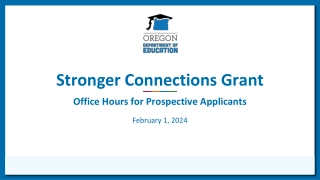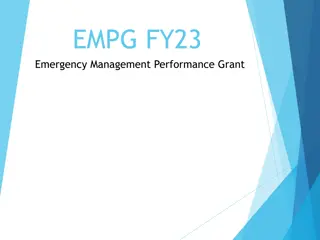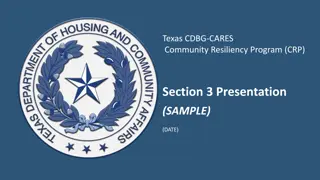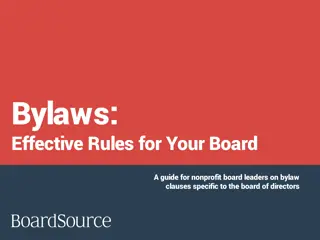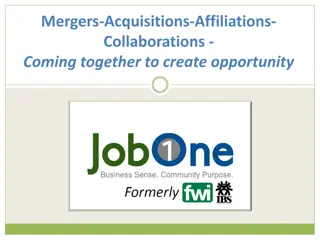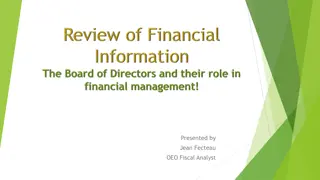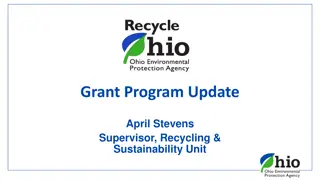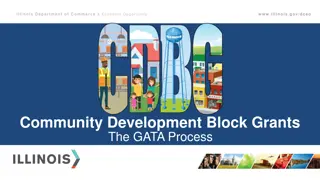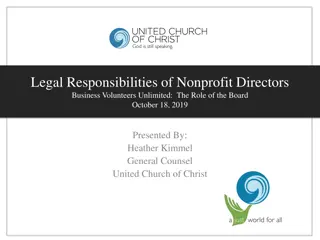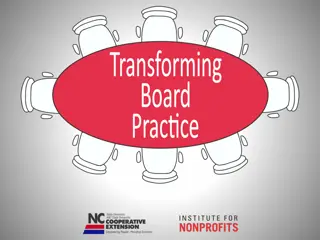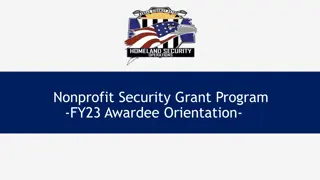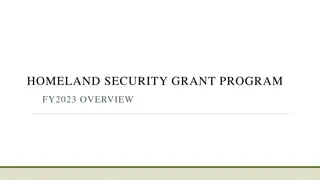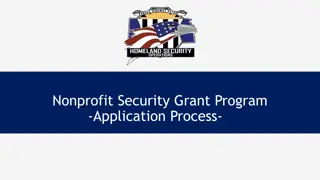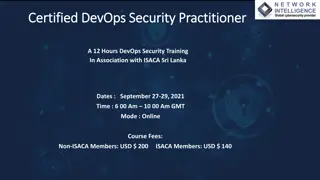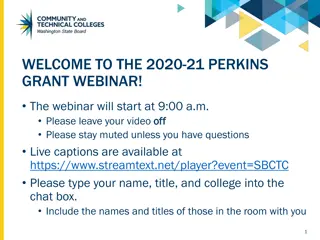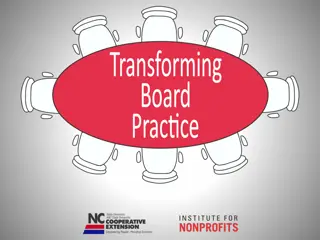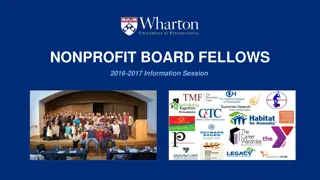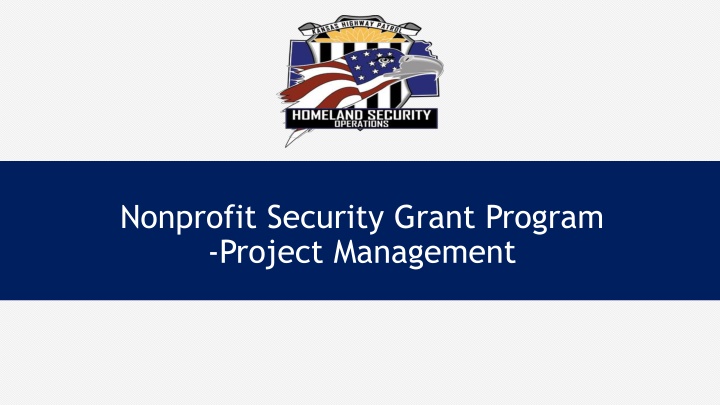
Nonprofit Security Grant Program: Project Management
This guide covers project management responsibilities, planning activities, training options, and examples of allowable expenses under the Nonprofit Security Grant Program. Learn about organizing documentation, managing security projects, and enhancing emergency preparedness for nonprofit organizations.
Download Presentation

Please find below an Image/Link to download the presentation.
The content on the website is provided AS IS for your information and personal use only. It may not be sold, licensed, or shared on other websites without obtaining consent from the author. If you encounter any issues during the download, it is possible that the publisher has removed the file from their server.
You are allowed to download the files provided on this website for personal or commercial use, subject to the condition that they are used lawfully. All files are the property of their respective owners.
The content on the website is provided AS IS for your information and personal use only. It may not be sold, licensed, or shared on other websites without obtaining consent from the author.
E N D
Presentation Transcript
Nonprofit Security Grant Program -Project Management
Project Manager Responsibilities Now that you have met all administrative requirements to include EHP approval and procurement responsibilities lets look at collecting and organizing documentation and proper management of your project through close-out activities. Planning Training Exercise Equipment & Accountability Management & Administration (M&A) Contracted Security Personnel Records Retention Revisiting Key requirement
PLANNING Funding may be used for security or emergency planning expenses and the materials required to conduct planning activities. Planning must be related to the protection of the facility and the people within the facility and should include consideration of access and functional needs considerations as well as those with limited English proficiency. Planning efforts can also include conducting risk and resilience assessments on increasingly connected cyber and physical systems, on which security depends, using the Infrastructure Resilience Planning Framework and related CISA resources.
Planning Examples Examples of planning activities allowable under this program include: Development and enhancement of security plans and protocols; Development or further strengthening of security assessments; Emergency contingency plans; Evacuation/Shelter-in-place plans; Coordination and information sharing with fusion centers; and Other project planning activities with prior approval from FEMA.
TRAINING Nonprofit organizations may use NSGP funds for the following training-related costs: Employed or volunteer security staff to attend security-related training within the United States Employed or volunteer staff to attend security-related training within the United States with the intent of training other employees or members/congregants upon completing the training (i.e., train-the-trainer type courses); and Nonprofit organization s employees, or members/congregants to receive on-site security training. Allowable training-related costs under the NSGP are limited to attendance fees for training and related expenses, such as materials, supplies, and/or equipment. Overtime, backfill, and travel expenses are not allowable costs.
Training Continued Allowable training topics are limited to the protection of critical infrastructure key resources, including physical and cybersecurity, target hardening, and terrorism awareness/employee preparedness such as Community Emergency Response Team (CERT) training, indicators and behaviors indicative of terrorist threats, Active Shooter training, and emergency first aid training. Additional examples of allowable training courses include: The Power of Hello , Stop The Bleed training, kits/equipment, and training aids; First Aid and other novice level you are the help until help arrives training, kits/equipment, and training aids; and Automatic External Defibrillator (AED) and AED/Basic Life Support training, kits/equipment, and training aids. Training conducted using NSGP funds must address a specific threat and/or vulnerability, as identified in the nonprofit organization s IJ. Training should provide the opportunity to demonstrate and validate skills learned as well as to identify any gaps in these skills. Proposed attendance at training courses and all associated costs using the NSGP must be included in the nonprofit organization s Investment Justification (IJ).
EXERCISE Funding may be used to conduct security-related exercises. This includes costs related to planning, meeting space and other meeting costs, facilitation costs, materials and supplies, and documentation. Exercises afford organizations the opportunity to validate plans and procedures, evaluate capabilities, and assess progress toward meeting capability targets in a controlled, low risk setting. All shortcomings or gaps including those identified for children and individuals with access and functional needs should be identified in an improvement plan. Improvement plans should be dynamic documents with corrective actions continually monitored and implemented as part of improving preparedness through the exercise cycle. The Homeland Security Exercise and Evaluation Program (HSEEP) provides a set of guiding principles for exercise programs, as well as a common approach to exercise program management, design and development, conduct, evaluation, and improvement planning. https://www.fema.gov/emergency-managers/national- preparedness/exercises/hseep . https://preptoolkit.fema.gov/web/hseep-resources/improvement-planning .
Definitions for Exercise Seminars generally orient participants to, or provide an overview of, authorities, strategies, plans, policies, procedures, protocols, resources, concepts, and ideas. As a discussion-based exercise, seminars can be valuable for entities that are developing or making major changes to existing plans or procedures. Seminars can be similarly helpful when attempting to gain awareness of, or assess, the capabilities of interagency or inter-jurisdictional operations. A game is a simulation of operations that often involves two or more teams, usually in a competitive environment, using rules, data, and procedures designed to depict an actual or hypothetic situation. Games explore the consequences of player decisions and actions and are therefore excellent tools to use when validating or reinforcing plans and procedures or evaluating resource requirements. Games Seminar A drill is a coordinated, supervised activity usually employed to validate a specific operation or function in a single agency or organization. Drills are commonly used to provide training on new equipment, develop or validate new policies or procedures, or practice and maintain current skills. Although like seminars, workshops differ in two important aspects: participant interaction is increased, and the focus is placed on achieving or building a product. Effective workshops entail the broadest attendance by relevant stakeholders. Products produced from a workshop can include new standard operating procedures, emergency operations plans, continuity of operations plans, and mutual aid agreements. To be effective, workshops should focus on a specific issue, and the desired objective, product, or goal must be clearly defined. Drill Functional exercises are designed to validate and evaluate capabilities, multiple functions and/or sub-functions, or interdependent groups of functions. FEs are typically focused on exercising plans, policies, procedures, and staff members involved in management, direction, command, and control functions. In FEs, events are projected through an exercise scenario with event updates that drive activity at the management level. An FE is conducted in a realistic, real-time environment; however, movement of personnel and equipment is usually simulated. Workshop Functional Exercise (FE) A TTX is typically held in an informal setting intended to generate discussion of various issues regarding a hypothetical, simulated emergency. TTXs can be used to enhance general awareness, validate plans and procedures, rehearse concepts, and/or assess the types of systems needed to guide the prevention of, protection from, mitigation of, response to, and recovery from a defined incident. Generally, TTXs are aimed at facilitating conceptual understanding, identifying strengths and areas for improvement, and/or achieving changes in attitudes. FSEs are typically the most complex and resource-intensive type of exercise. They involve multiple agencies, organizations, and jurisdictions and validate many facets of preparedness. FSEs often include many players operating under cooperative systems such as the Incident Command System or Unified Command. Tabletop Exercise (TTX) Full Scale Exercise (FSE)
Pre-Approval of Planning/Training/Exercise Moving forward- All Planning, Training and Exercise activities where NSGP funds will be utilized, a pre- approval will be required prior to the activity date. This form was created to help ensure that all Planning, Training and Exercise expenses are pre-approved, allowable, and all required documentation is obtained and submitted for a seamless reimbursement process. When sending in your reimbursement form and itemized invoice, please include any supporting source documentation to NSGP.KHP@KS.GOV and carbon copy KHP.Homeland@KS.GOV
EQUIPMENT Allowable costs are focused on target hardening and physical security enhancements. Funding can be used for the acquisition and installation of security equipment on real property (including buildings and improvements) owned or leased by the nonprofit organization, specifically in prevention of and/or protection against the risk of a terrorist attack. This equipment is limited to select items in the following two sections of items on the Authorized Equipment List (AEL): Physical Security Enhancement Equipment (Section 14); and Inspection and Screening Systems (Section 15). Notification and Warning Systems; and Radios and Public Warning Systems Public Address, Handheld, or Mobile. Unless otherwise stated, equipment must meet all mandatory statutory, regulatory, and FEMA-adopted standards to be eligible for purchase using these funds, including the Americans with Disabilities Act. In addition, recipients will be responsible for obtaining and maintaining all necessary certifications and licenses for the requested equipment, whether with NSGP funding or other sources of funds (seethe Maintenance and Sustainment section below for more information). In addition, recipients that are using NSGP funds to support emergency communications equipment activities must comply with the SAFECOM Guidance on Emergency Communications Grants, including provisions on technical standards that ensure and enhance interoperable communications. This SAFECOM Guidance can be found at https://www.cisa.gov/safecom/funding .
Equipment & Accountability Applicants should analyze the cost benefits of purchasing versus leasing equipment, especially high-cost items and those subject to rapid technical advances. Large equipment purchases must be identified and explained. For additional guidance, please reach out to the SAA at NSGP.KHP@KS.GOV The installation of certain equipment may trigger EHP requirements. Please reference the EHP sections in the NOFO and this Manual for more information. Additionally, some equipment installation may constitute construction or renovation. Subrecipients should have a method of accountability for equipment and supplies purchased with NSGP funding. Example- Access control, access to technology, access to sensitive materials. A plan/protocol should be put in place to identify who has access, log of check-out/check-in, what happens if that person who has access leaves the organization etc.
MANAGEMENT & ADMINISTRATION (M&A) M&A costs are for activities directly related to the management and administration of the award. M&A activities are those defined as directly relating to the management and administration of NSGP funds, such as financial management and monitoring. M&A expenses must be based on actual expenses or known contractual costs. Requests that are simple percentages of the award, without supporting justification, will not be allowed or considered for reimbursement. M&A costs are not operational costs, they are the necessary costs incurred in direct support of the grant or as a result of the grant and should be allocated across the entire lifecycle of the grant. Examples include preparing and submitting required programmatic and financial reports, establishing and/or maintaining equipment inventory, documenting operational and equipment expenditures for financial accounting purposes, and responding to official informational requests from state and federal oversight authorities. Note: Must be able to separately account for M&A costs associated with the NSGP-S award.
M&A SUMMARY You may only request M&A reimbursement for: Hiring of full-time or part-time staff or contractors/consultants responsible for activities relating to the management and administration of NSGP funds. Hiring of contractors/consultants must follow the applicable federal procurement requirements at 2 C.F.R. 200.317-200.327; and Meeting-related expenses directly related to M&A of NSGP funds. M&A costs are allowed under this program as described below: Nonprofit (Subrecipient) for NSGP-UA and NSGP-S, and Community Project Funding M&A: Nonprofit organizations that receive a subaward under this program may use and expend up to the percent noted in the relevant fiscal year (FY) NOFO for M&A purposes associated with the subaward. All these costs must reasonable and be supported with documentation.
Contracted Security Personnel Contracted Security Personnel Contracted security personnel are allowed under this program only as described in the NOFO and Manual and comply with guidance set forth in IB 421b and IB 441. NSGP funds may not be used to purchase equipment for contracted security. The recipient must be able to sustain this capability in future years without NSGP funding, and a sustainment plan will be required as part of the closeout package for any award funding this capability. Additionally, NSGP recipients and subrecipients may not use more than 50 percent of their awards to pay for personnel activities unless a waiver is approved by FEMA. For more information on the 50 percent personnel cap and applicable procedures for seeking a waiver, please see IB 421b, Clarification on the Personnel Reimbursement for Intelligence Cooperation and Enhancement of Homeland Security Act of 2008 (Public Law 110-412 the PRICE Act). If Contracted Security Personnel are providing Planning, Training or Exercise activities, please ask them to obtain signature of participants for the reimbursement process. A generic sign-in sheet, that can be modified, is available or the Contractor can utilize their own version. Please make sure your documents are neat and organized, if it looks neat, legible and organized with the type of activity, date, location, typed or printed names with individual signatures. There should be a sign-in sheet for each day of activity. If you utilize a virtual platform, you may ask attendees to type their names into the chat and provided a print of the chat response in place of the sign-in sheet. Also, if you utilize a badge scanning system, you can provide a printout of attendance.
Records Retention Records Retention Period of Financial records, supporting documents, statistical records, and all other non-federal entity records pertinent to a federal award generally must be maintained for at least three years from the date of successful close of the award, which is normally 90 days after the end of FEMA s performance period. Types of Records to Retain FEMA requires that non-federal entities maintain the following documentation for federally funded purchases: Specifications; Solicitations; Competitive quotes or proposals; Basis for selection decisions; Purchase orders; Contracts; Invoices; and Canceled checks. You should keep detailed records of all transactions involving the grant. FEMA may at any time request copies of any relevant documentation and records, including purchasing documentation along with copies of canceled checks for verification. See, e.g., 2 C.F.R. 200.318(i), 200.334, 200.337. Preparedness Grants Manual | May 2022 44 In order for any cost to be allowable, it must be adequately documented per 2 C.F.R. 200.403(g). Nonfederal entities who fail to fully document all purchases may find their expenditures questioned and subsequently disallowed.
Revisiting Procurement Thresholds Expense at or less than $4,999.99 o no competitive bidding- do shop around for best quality at a reasonable price. Best practice is research best costs with at least 3 vendors. o Note* if you are spending more than $4,999.99 in one fiscal year on one vendor go to the next threshold o Follow your policy fiscal year or state policy Expense between $5,000 to $24,999.99 o minimum of three (3) quotes received Expense is between $25,000 to $49,999.99 o Sealed bid process used, Invitation to Bid, Public Bulletin Board (your nonprofit website) minimum ten calendar days o Note* Best practice is to post all bids on KS Register that exceed $25,000.00 Expense is at or greater than $50,000 o Sealed bid process used, Invitation to Bid, post on Kansas Register https://sos.ks.gov/publications/kansas-register.html - minimum of ten business days, excluding holidays and minus the first & last day of posting (+2). You can utilize M&A for this cost-as long as it was listed and approved in your IJ Procurement & Reimbursement resources are available at http://www.datacounts.net/nsgp for review or refresher.
Revisiting the Reimbursement process Now that the work is completed- you have inspected and approve of final service or product- Complete the provided Reimbursement Request Form Prepare, organize, and attach your supporting documentation that will match your reimbursement requests Supporting documentation- also known as Source Documentation includes as applicable. Procurement Checklist Bids or quotes Bid or quote tabulation sheet- this sheet lists out all bids or quotes obtained Pre-Approval forms such as for Planning/Training/Exercise also email approvals Correspondence Sealed bid information Cancelled checks if the cancelled check is for multiple charges or invoices, please note this (breaking out costs) on the copy or summary you will be providing the SAA Any other documents that support your itemized invoice listing only pre-approved items or activities Electronic reimbursement requests will be sent to the SAA at nsgp.khp@ks.gov and carbon copy KHP.Homeland@KS.GOV . Email subject should be- Reimbursement Request, Fiscal year, nonprofit name, reimbursement number (Reimbursement Request FY22 name of your nonprofit #1) Note* submit reimbursements as they are incurred to ensure timely pass-through of funds. If proof of payment is not submitted at the time of reimbursement, you must have proof of payment within 45 days of submitting the reimbursement request but as soon as possible.
Revisiting Payment & Proof of Payment Setting up a method of tracking and open/transparent communication between all parties managing funding in the beginning of your project is key. Carbon copy Create an accessible spreadsheet or checklist Primary project manager listed in you IJ must have visibility and oversight as they are ultimately responsible for this funding opportunity. Reimbursement is the preferred method. However, if you are drawing down funds for an itemized invoice, you must be paying your vendor within 45 days of service and providing the SAA proof of payment. Failure to do so in an organized and reasonable time will limit this funding to reimbursement only, where you must pay the vendor and provide proof of payment at the time reimbursement is requested. If individuals on your team are struggling to understand the processes, training is always available. http://www.datacounts.net/nsgp or email NSGP.KHP@KS.GOV for help. Our team is committed to your success.
REVISITING END USER RESPONSIBILITIES An inventory is required to be maintained by the End User for the life of equipment and reconciled semi-annually. The SAA will work with the End User to reconcile annual inventory no later than September 30th. Next Annual Inventory due September 30, 2024. The SAA is required to conduct two on-sight visits to monitor equipment requirements. Equipment is to be maintained in good working order for the life of equipment Training should be included in the cost of Equipment where training is required for safe operation, and we encourage cross-training other members Planning, Training, Exercise and Equipment should consider ADA compliance (access and functional needs) Obtain pre-approval for any reasonable modifications to the project.
Revisiting Monitoring All equipment with a threshold of $5,000.00 or more will need to be tagged and monitored by the SAA at least twice- once during the open grant period and once after the close. The SAA will reach out to schedule these monitoring visits with you or an appointee, so please keep us up to date on any contact changes. Monitoring will also include methods of tracking and controlling Access to your facility and systems such as virtual platforms and sensitive information. We may also look at plans you have in place to limit or access control to safeguard your Soft Target/ Crowded Places. Please access http://www.datacounts.net/nsgp for tools, resources, project management training and updates. If you have any questions pertaining to the guidance above or need any assistance, please do not hesitate to contact any of us at NSGP.KHP@KS.GOV .
RESOURCES Nonprofit Security Grant Program resources website http://datacounts.net/nsgp FEMA-NSGP Guidance https://www.fema.gov/grants/preparedness/nonprofit-security Preparedness Grants Manual https://www.fema.gov/grants/preparedness Kansas Procurement https://www.admin.ks.gov/offices/procurement-and-contracts Code of Federal Regulations https://www.ecfr.gov/cgi-bin/ECFR?page=browse Kansas Homeland Security Preparedness Grant Programs Policy Manual http://datcounts.net/nsgp
CONTACTS- GENERAL NSGP.KHP@KS.GOV Captain Justin Bramlett K-425 KHP- Homeland Security/Emergency Operations 122 SW 7th Street, Topeka, KS 66603-3847 (785)220 0350 Justin.Bramlett@ks.gov Lieutenant Edna Cordner K-299 KHP- Homeland Security / Emergency Operations 122 SW 7th Street, Topeka, KS 66603-3847 785-207-0423 (Cell) NSGP.KHP@KS.GOV Lieutenant Cory Beard K-18 KHP- Homeland Security/Emergency Operations 122 SW 7th Street, Topeka, KS 66603-3847 785-913-461-0302 Cory.beard@ks.gov Melanie Lawrence KHP- Homeland Security/Emergency Operations Program Consultant II 122 SW 7th Street, Topeka, KS 66603-3847 785-296-6654 (Office) 785-256-5191 (Cell) NSGP.KHP@KS.GOV Connie Satzler EnVisage Consulting Web portal and IJ assistance 6847 Anderson Ave. Manhattan, KS 66503 Phone: (785) 410-0410 csatzler@kansas.net Http://www.datacounts.net/nsgp
Questions? NSGP.KHP@KS.GOV

